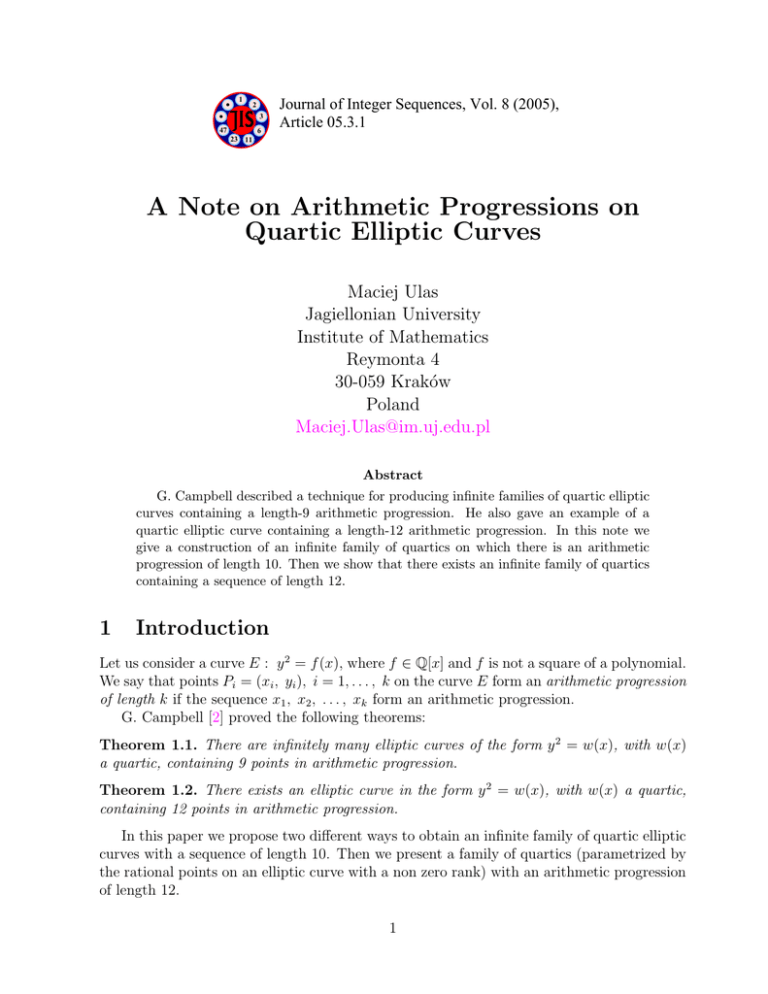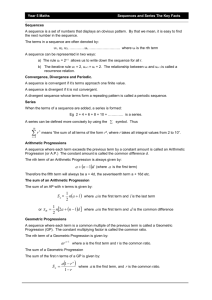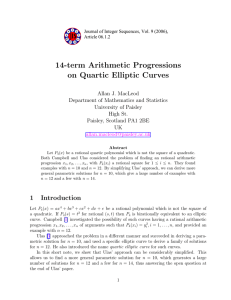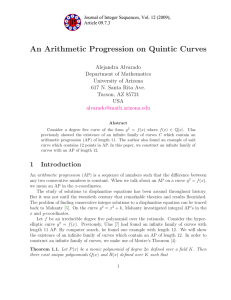A Note on Arithmetic Progressions on Quartic Elliptic Curves Maciej Ulas Jagiellonian University
advertisement

1
2
3
47
6
Journal of Integer Sequences, Vol. 8 (2005),
Article 05.3.1
23 11
A Note on Arithmetic Progressions on
Quartic Elliptic Curves
Maciej Ulas
Jagiellonian University
Institute of Mathematics
Reymonta 4
30-059 Kraków
Poland
Maciej.Ulas@im.uj.edu.pl
Abstract
G. Campbell described a technique for producing infinite families of quartic elliptic
curves containing a length-9 arithmetic progression. He also gave an example of a
quartic elliptic curve containing a length-12 arithmetic progression. In this note we
give a construction of an infinite family of quartics on which there is an arithmetic
progression of length 10. Then we show that there exists an infinite family of quartics
containing a sequence of length 12.
1
Introduction
Let us consider a curve E : y 2 = f (x), where f ∈ Q[x] and f is not a square of a polynomial.
We say that points Pi = (xi , yi ), i = 1, . . . , k on the curve E form an arithmetic progression
of length k if the sequence x1 , x2 , . . . , xk form an arithmetic progression.
G. Campbell [2] proved the following theorems:
Theorem 1.1. There are infinitely many elliptic curves of the form y 2 = w(x), with w(x)
a quartic, containing 9 points in arithmetic progression.
Theorem 1.2. There exists an elliptic curve in the form y 2 = w(x), with w(x) a quartic,
containing 12 points in arithmetic progression.
In this paper we propose two different ways to obtain an infinite family of quartic elliptic
curves with a sequence of length 10. Then we present a family of quartics (parametrized by
the rational points on an elliptic curve with a non zero rank) with an arithmetic progression
of length 12.
1
2
Arithmetic Progressions of Length 10
The proof of the first theorem is similar to the one given by G. Campbell [2].
Theorem 2.1. There are infinitely many quartic elliptic curves y 2 = f (x) containing 10
points in arithmetic progression.
Proof. Let us consider the following polynomial
2
Pt (x) = (x − 9x − 4t)
9
Y
(x − i) ∈ Q(t)[x].
(2.1)
i=0
Then, we have
Pt (x) = Qt (x)2 − Ft (x),
where Qt is the unique monic polynomial defined over Q(t) such that Ft has degree 4.
The discriminant of the polynomial Ft (x) is non zero for t ∈ Q \ S, where
S = {±1, ±2, ±4, −5, −6, −8, −11}.
Hence, for such parameters t, the quartic elliptic curve
Et : y 2 = Ft (x)
(2.2)
contain the points Pi = (i, Qt (i)) for i = 0, . . . , 9 which form an arithmetic progression of
length 10 on the curve Et .
3
The sequence of length 12
There doesn’t seem to be a way to construct an infinite family of quartics with an arithmetic
progression of length 12 from family of curves (2.2). In this section we shall construct
another family which will be better for our purposes. First let us consider the polynomial
f ∈ Q[p, q, r, s, t][x]
4
X
ai x i ,
f (x) =
i=0
where
a0 = 5p2 − 10q 2 + 10r2 − 5s2 + t2 ,
1
a1 = (−77p2 + 214q 2 − 234r2 + 122s2 − 25t2 ),
12
1
a2 = (71p2 − 236q 2 + 294r2 − 164s2 + 35t2 ),
24
1
a3 = (−7p2 + 26q 2 − 36r2 + 22s2 − 5t2 ),
12
1
a4 = (p2 − 4q 2 + 6r2 − 4s2 + t2 ).
24
We have
2
f (1) = p2 ,
f (2) = q 2 ,
f (3) = r 2 ,
f (4) = s2 ,
f (5) = t2 ,
so we see that
E : y 2 = f (x)
is a five parameter family of quartics containing an arithmetic progression of length 5. In
order to obtain a family with a sequence of length 10 we have to consider the following
system of equations
f (6) = p2 − 5q 2 + 10r2 − 10s2 + 5t2 = P 2 ,
2
2
2
2
2
2
f (7) = 5p − 24q + 45r − 40s + 15t = Q ,
(3.1)
f (8) = 15p2 − 70q 2 + 126r2 − 105s2 + 35t2 = R2 ,
f (9) = 35p2 − 160q 2 + 280r2 − 224s2 + 70t2 = S 2 ,
f (10) = 70p2 − 315q 2 + 540r2 − 420s2 + 126t2 = T 2 ,
in integers p, q, r, s, t, P, Q, R, S, T . Since the general solution is hard to obtain we will
look for particular solutions with P = t, Q = s, R = r, S = q, T = p. Then, in this case it
is easy to realize that (3.1) is equivalent to
(
p2 = 15r2 − 35s2 + 21t2 ,
(3.2)
q 2 = 5r2 − 9s2 + 5t2 .
Making a substitution (p, r, s, t) = (p, a + p, b + p, c + p) we get a parametrized solution
of the first equation in (3.2)
p = 15a2 − 35b2 + 21c2 ,
r = −15a2 + 70ab − 35b2 − 42ac + 21c2 ,
(3.3)
s = 15a2 − 30ab + 35b2 − 42bc + 21c2 ,
t = 15a2 − 35b2 − 30ac + 70bc − 21c2 .
Now inserting r, s, t from (3.3) to the second equation in (3.2), we obtain
q 2 = 441c4 − 168(15a − 7b)c3 + 2(675a2 + 2520ab − 2303b2 )c2
+ 40(45a3 − 189a2 b + 63ab2 + 49b3 )c
+ 25(9a4 − 96a3 b + 278a2 b2 − 224ab3 + 49b4 ).
(3.4)
Moreover, if we take b = 3(a + 1), c = 2(a + 1), we get that q = 3(56a2 + 142a + 91). Finally
we have
p = T = −3(72a2 + 154a + 77),
2
q = S = 3(56a + 142a + 91),
r = R = −3(40a2 + 112a + 77),
s = Q = 3(24a2 + 68a + 49),
t = P = −3(8a2 + 6a − 7),
3
(3.5)
which is a solution of (3.1). Specializing the polynomial f as given by (3.5) we obtain
fa (x) =
4
X
ai x i ,
i=0
where
a0
a1
a2
a3
a4
= 9(7744a4 + 25216a3 + 22544a2 − 784a − 5831),
= − 66(a + 1)(16a + 21)(24a2 − 52a − 119),
= 3(a + 1)(16a + 21)(48a2 − 709a − 1085),
= 66(a + 1)(5a + 7)(16a + 21),
= − 3(a + 1)(5a + 7)(16a + 21),
and the discriminant Ra of the polynomial fa is
Ra = − 419904(a + 1)4 (2a + 3)2 (4a + 5)2 (2a + 7)2 (4a + 7)2 (5a + 7)3
× (6a + 7)2 (12a + 17)2 (16a + 21)4 (1008a2 + 1831a + 623).
Then for a ∈ Q \ W , where
W := {−1, −3/2, −5/4, −7/2, −7/4, −7/5, −7/6, −17/12, −21/16},
we get a nontrivial quartic elliptic curve
Ca : y 2 = fa (x)
containing an arithmetic progression of length 10.
Now we are ready to prove the following:
Theorem 3.1. There are infinitely many quartic elliptic curves y 2 = f (x) containing 12
points in arithmetic progression.
Proof. The curve Ca defined above contains the 10 points with x = 1, . . . , 10. Observe that
fa (0) = fa (11) = 9(7744a4 + 25216a3 + 22544a2 − 784a − 5831).
Now, consider the curve:
E : Y 2 = 9(7744a4 + 25216a3 + 22544a2 − 784a − 5831).
A short computer search reveals that P = (−1, 15) is a rational point on the quartic E.
Using the program APECS [3] we found that E is birationally equivalent to the elliptic curve
E 0 : y 2 = x3 − x2 − 33433x + 2213737.
For the curve E 0 we have
Tors E(Q) = {O, (127, 0)},
and with the help of mwrank [4] we see that the free part of E 0 is generated by
4
G1 = (77, −300), G2 = (−193, −1200), G3 = (−48, −1925).
Hence the curve E has an infinite number of rational points and it is clear that all but finitely
many of them leads to the quartic Ca containing arithmetic progression of length 12.
It is natural to state the following question:
Open Question 3.2. Is there an quartic elliptic curve E containing a length 13 arithmetic
progression?
4
Acknowledgment
I would like to thank anonymous referee for his/her valuable comments.
References
[1] A. Bremner, On arithmetic progressions on elliptic curves. Experiment. Math. 8 (1999),
409–413.
[2] G. Campbell, A note on arithmetic progressions on elliptic curves. Journal of Integer
Sequences, Paper 03.1.3, 2003.
[3] I. Connel, APECS, available from ftp.math.mcgill.ca/pub/apecs/.
[4] J. Cremona, mwrank program, available from
http://www.maths.nottingham.ac.uk/personal/jec/ftp/progs/.
2000 Mathematics Subject Classification: 11G05, 11B25.
Keywords: elliptic curves, arithmetic progression.
Received November 11 2004; revised version received May 21 2005. Published in Journal of
Integer Sequences, May 24 2005.
Return to Journal of Integer Sequences home page.
5






